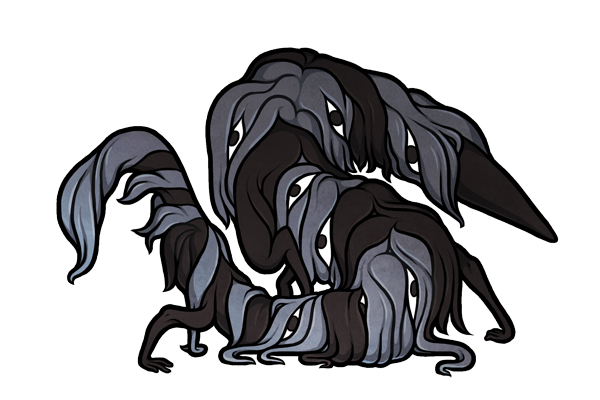

cocalidroni
the wags
prefix cocali suffix droni
zolapsis trov
physical appearance
The cocalidroni /koʊˈkæləkədɹoʊni/ is a black and slate-colored stranger with five to eleven limbs, and an elastic rubber bodyᴕ coated in wooly fibers. Its hard, glossy eye markings peer outwards from regular parts in its wool, which seems artificial, and exudes a harsh odorᴉ in turn. Each of the cocalidroni's hairs is 30% as thick as an average human hair, but display supreme durability to both cutting and plucking. Even swift slashes from knives, let along hand-grips, slip with ease between the smooth tufts of the cocalidroni's mane. These hairs do not shed and do not become knotted, nor does glue, dirt, or oil affix to the locks. This hairy body thus serves to protect the stranger's soft, foam-like interior, which is no more durable than the average toy, and cannot recover from destruction. Even a single deep cut causes the cocalidroni to go limp, collapsing in a heap with minimal further response.
ᴕ Loosely symmetrical, but not always.
ᴉ Is this your first taste of new plastic? It's not very good.
The cocalidroni speaks through a range of low-frequency tones that it emits from its head and limb-tips, these utterances resembling the bleeps, chirps, and sustained notes of an early electronic synthesizer.Ꮟ
Ꮟ Particularly, the Radiomaker LOVELOVER667 v. 2 (2076) – which you may know for its field amplification when used for psycholy extraction. Now, don't get too naughty just yet – we've still got a few more wires to attach before we're going to see any kind of amplification, but if you've been holding onto those dead batteries like I mentioned...
Elly Prauzner. NTSC-K vacuum tubes (supplement for rotational pressure attachments).
musical boops and beeps.

environment and generation
The cocalidroni appears in schools, theaters, opera houses, museums, auditoriums, libraries, government facilities, offices, and a wide range of other areas which, though frequented by large numbers of people, are mainly given to quiet, peaceful activity.
The cocalidroni generates in unseen locations, such as as behind large displays, beneath temporary stage platforms, inside of open but overturned bins, and on top of high shelves, although it never generates in spaces in which it can become permanently trapped. The strain is limp and hairless at first, but once it swells to full size (usually overnight), it stands up and scratches at its body with both annoyance and desperation, each motion causing its long hair to grow abruptly, until it is fully shaggy.
behaviour
The cocalidroni is both boisterous and blusterous in demeanor, bounding through its environment with slack, cavorting surges. It moves towards objects and sights that display some other level of animation (such as flashing lights or turning wheels) although the fickle strain's interest remains captured for only minutes at a time.
In addition, the level of movement within an area influences the cocalidroni's own energy level. A cocalidroni in a busy environment bounds and tumbles with great excitement, while a cocalidroni exposed to only a ticking clock as its sole point of stimulus moves in sluggish rolls. The strain thus requires some constant minimum level of exposure to visual stimulus in order to move, growing listless and then still after one hour without nearby movement.
During those brief lapses in its gamboling, the cocalidroni appears to take some joy in making its overall shape indiscernible, and curls and twists over itself in order to transform its appearance into that of a tangled mass of fibers. It also uses this behaviour to hide itself from those predatory strains that prey upon the cocalidroni. Even strains which hunt based on sound or other criteria become unable to discern the cocalidroni as a target once its body is sufficiently entangled.
When meeting another of its kind, the cocalidroni shakes its body while advancing forward, growing playful once it touches noses with its companion for the first time. Groups of cocalidroni chase each other as though playing tag (with much flapping of the tail and shaking of the midsection), or engage in what seems to be competitive coursing throughout their territory. Because of its response to nearby movement, the presence of another cocalidroni allows both individuals greater (but not indefinite) animation. Though it is benefited by sociality, the cocalidroni rarely remains with another of its kind for more than a day or two, with both individuals capering off without closing interaction.
interactions with sensitives
The cocalidroni is curious towards any sensitive that it encounters, circling them with flopping sway of the head and tail, then staring backward at the sensitive's face as though waiting to be chased. The stranger seems prone, however, to abrupt and unpredictable reactions. Following a cocalidroni may elicit initial delight from the stranger, only for it to appear abruptly startled, at which point it will abandon its interest in the sensitive and grow evasive. Its response to aggression is similarly paradoxical. Some attacks cause the cocalidroni to shudder and curl up, while others cause to become more playful, raising its limbs, sweeping its tail from side to side – even laying on its side and rolling its hands in the air above it, as though balancing an invisible ball.
While the cocalidroni presents no aggressive threat towards a sensitive, as it moves, it releases an invisible vapor by-product into the air around it. This gaseous substance, when inhaled, causes a pressure behind the left eye, build-up of lymphatic fluid around the temples and nasal-passages, and numbness of the tip of the tongue. Similarly, physical contact with the cocalidroni's flesh and fibers causes a rash on the skin, with the hair follicles being particularly affected, large tufts often falling out altogether.
In addition to this proximal effect, the cocalidroni's presence causes 3% of blinks to send a sensitive into a state of closed-eye trance, during which the sensitive remains in position for the next twelve hours, unless moved by outside forces. This span of time seems to take no longer than a normal blink. During this trance, the sensitive is unable to react to all stimulus, including the pain of grievous injury, collapsing to the ground and becoming limp if pushed or pulled, or should severe muscle fatigue occur. The cocalidroni rarely lingers once the sensitive has entered this state, leaving the affected individual to the mercy of their environment.
aging and death
The cocalidroni displays no overt signs of aging, and instead, dies with a sudden collapse, often mid-bound. Its hair immediately loosens its body, scattering around the cocalidroni's rubbery corpse. Over the coming months, the dead flesh breaks down into the same gaseous substance it exuded in life, the physical body growing more and more brittle until vaporizing altogether.
Other cocalidroni display no regard for the loss of one of their companions, but display enormous joy traipsing through the heaps of fur left behind.
The cocalidroni's fibers degrade only after fourteen thousand years.



